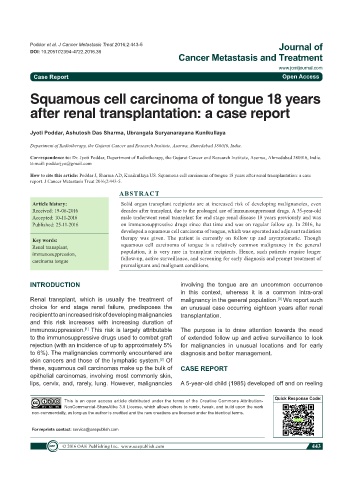Page 453 - Read Online
P. 453
Poddar et al. J Cancer Metastasis Treat 2016;2:443-5 Journal of
DOI: 10.20517/2394-4722.2016.36
Cancer Metastasis and Treatment
www.jcmtjournal.com
Case Report Open Access
Squamous cell carcinoma of tongue 18 years
after renal transplantation: a case report
Jyoti Poddar, Ashutosh Das Sharma, Ubrangala Suryanarayana Kunikullaya
Department of Radiotherapy, the Gujarat Cancer and Research Institute, Asarwa, Ahmedabad 380016, India.
Correspondence to: Dr. Jyoti Poddar, Department of Radiotherapy, the Gujarat Cancer and Research Institute, Asarwa, Ahmedabad 380016, India.
E-mail: poddarjyo@gmail.com
How to cite this article: Poddar J, Sharma AD, Kunikullaya US. Squamous cell carcinoma of tongue 18 years after renal transplantation: a case
report. J Cancer Metastasis Treat 2016;2:443-5.
ABSTRACT
Article history: Solid organ transplant recipients are at increased risk of developing malignancies, even
Received: 19-06-2016 decades after transplant, due to the prolonged use of immunosuppressant drugs. A 35-year-old
Accepted: 10-11-2016 male underwent renal transplant for end stage renal disease 18 years previously and was
Published: 25-11-2016 on immunosuppressive drugs since that time and was on regular follow up. In 2016, he
developed a squamous cell carcinoma of tongue, which was operated and adjuvant radiation
Key words: therapy was given. The patient is currently on follow up and asymptomatic. Though
Renal transplant, squamous cell carcinoma of tongue is a relatively common malignancy in the general
immunosuppression, population, it is very rare in transplant recipients. Hence, such patients require longer
carcinoma tongue follow-up, active surveillance, and screening for early diagnosis and prompt treatment of
premalignant and malignant conditions.
INTRODUCTION involving the tongue are an uncommon occurrence
in this context, whereas it is a common intra-oral
Renal transplant, which is usually the treatment of malignancy in the general population. We report such
[3]
choice for end stage renal failure, predisposes the an unusual case occurring eighteen years after renal
recipient to an increased risk of developing malignancies transplantation.
and this risk increases with increasing duration of
[1]
immunosuppression. This risk is largely attributable The purpose is to draw attention towards the need
to the immunosuppressive drugs used to combat graft of extended follow up and active surveillance to look
rejection (with an incidence of up to approximately 5% for malignancies in unusual locations and for early
to 6%). The malignancies commonly encountered are diagnosis and better management.
skin cancers and those of the lymphatic system. Of
[2]
these, squamous cell carcinomas make up the bulk of CASE REPORT
epithelial carcinomas, involving most commonly skin,
lips, cervix, and, rarely, lung. However, malignancies A 5-year-old child (1985) developed off and on reeling
Quick Response Code:
This is an open access article distributed under the terms of the Creative Commons Attribution-
NonCommercial-ShareAlike 3.0 License, which allows others to remix, tweak, and build upon the work
non-commercially, as long as the author is credited and the new creations are licensed under the identical terms.
For reprints contact: service@oaepublish.com
© 2016 OAE Publishing Inc. www.oaepublish.com 443

